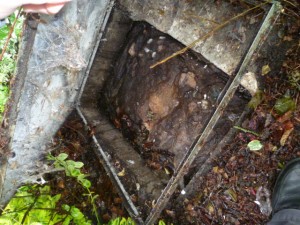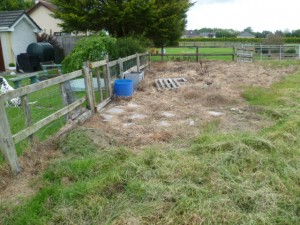How septic tanks work

Septic tanks are designed to allow liquids to flow through the tank and enter a percolation area without causing damage to the environment. Waste waters enter the tank and the flow is reduced through a series of baffles allowing the solids to sink to the bottom. Additionally, smaller particles float to the surface creating a scum. By holding the water in the system, suspended solids are removed and much of the sludge decomposes through natural aerobic and anaerobic processes.
In turn the semi-treated liquid is allowed to exit the tank into the percolation area and beyond.
Emptying Frequency.
There is no hard and fast rule, but for a septic tank to work efficiently the sludge (solids) needs to be removed based on the capacity of the tank and the use it is subjected to. The frequency of “de-sludging” will depend on size of the property and the number of occupants. However, most will require emptying at least once a year are in the case of modern biocycle system or secondary treatment systems according to the manufacturer’s specifications.
Tips in improving efficiency of septic tanks.
- Don’t dispose of: commercial chemicals, medicines, disposable nappies, incontinence pads or hygiene products down the toilet
- Don’t use large quantities of biological cleaning agents and bleach
- Don’t hose down the baffles and media areas of the tank. It is important for the bacterial media to remain and restart the biological process
- Do have the septic tank “de-sludged” regularly
- Do use biologically friendly products
Typical Problems and Solutions
Odour
Likely cause, Sludge particles leaving the septic tank and entering the percolation area or sludge has blocked the exit and the tank is overflowing.
Solutions:Have the tank “de-sludged” or emptied.
System backing-up
Likely blockage in the in-let pipe, blockage in the out-let pipe. percolation area blocked.
Solution:Clear in-let and/or out-let pipe. Remove and replace percolation area.
Septic Tank refilling immediately after emptying
Likely, high water table. Ground water enters the tank via the percolation area.
Solution:None. (possible solution is to increase the height of the area were septic tank and percolation area ore located-expensive and not always a solution)
Septic Tank refilling immediately after emptying
Likely, High water table : Tank ruptured allowing ground water to enter the tank.
Solution:Clear and clean tank, inspect, repair or replace.
Differences between septic tanks and biocycle (secondary treatment systems).

A septic tank does not have any movable parts. its basically a two chamber concrete tank that uses anaerobic bacterial action to break down effluent waste.
Biocycle and other secondary treatment systems have movable parts such as maceraters, aerators etc to aerobically break down the effluent and need a source of electric power to operate.
Biocycle / secondary treatment systems have shown to breakdown a higher percentage of solid waste and have safer effluent than septic tanks as the sludge decomposes through a mechanical assisted aerobic and anaerobic process. This can be twice as efficient as a non-mechanical assisted aerobic and anaerobic process in a traditional septic tank.
The requirement to use a septic tank or secondary treatment system is usually dependent on the site conditions, however, most Local Authorities (following a site assessment), will now require the use of a treatment system fitted by an approved contractor with appropriate professional indemnity insurance. Always check with your Local Authority before carrying out any renewal works to an existing septic tank.
An occupier of a property can be subject to substantial penalies if their septic tank or secondary treatment system is found to be polluting the environment.
General Information and Running Costs
The septic tank’s main function is to remove solids from the effluent, allowing a liquid effluent to soak into the soil through the percolation area.
The efficiency of septic tanks can vary significantly, frequent desludging of ineffective septic tanks can prevent anaerobic digestion of waste materials further reducing the efficiency of septic tanks.
A biocycle system or a secondary treatment system, is a more efficient and effective treatment system that incorporates a septic tank and a submerged aerated filter for secondary treatment within a single tank. The desludging intervals can also extend up to seven and more years according to some manufacturers. These secondary treatment systems will normally require to be serviced by an approved contractor on a yearly basis according to the manufacturer’s specifications.
A properly designed and installed secondary treatment system, can be up to twice as efficient as a traditional septic tank system in breaking down waste and discharging a cleaner effluent to the environment.
A secondary treatment system should have all paper work including design and installation assessments, site assessment and planning conditions available for inspection to confirm that it has been installed to standards and complies to planning permission requirements.
Running costs, depending on the type of secondary treatment system in use, a secondary treatment system runs on electricity continuously and would be expected to consume at least as much power as a fridge.
The treatment system will also require to be desludged as per manufacturors spectifications.
There is also an annual service charge for the inspection of the secondary treatment system plus the cost of labour and parts if they need to be replaced or repaired.
Pending Legislation on the Licensing and Regulation of Septic Tanks
The European Court of Justice has ruled against Ireland for failing to have a proper system of licensing and regulating individual septic tanks.
It is estimated that there are over 400,000 septic tanks in Ireland.
It is accepted that many septic tanks and percolation areas have been constructed in areas not suitable for same and their maintenance is often ignored.
Ireland is required to introduce a scheme to insure that septic tanks and waste water disposal are in compliance with EU Regulations and to maintain compliance into the future.
It is expected that the proposed scheme would include a
- scrappage remit to facilitate the replacement of inefficient / polluting septic tanks and treatment systems
- an inspection schedule to ensure ongoing maintainance and monitoring of septic tanks
- a licensing system that is renewable
- an enforcement element
Operation of Septic Tank inspection scheme.
Some commentators consider that a system similar to the NCT (National Car Test) would work, in that each property owner would be given a date when an Inspector is to call to their property. The property owner would allow for access to the septic tank including relevant documentation and maintenance records. The costs of the inspection would likely be carried by the property owner.
If the septic tank is found to be working correctly, then a certificate would be issued and remain valid for a limited number of years.
